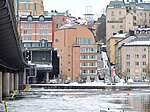Maria Magdalena Church

The Church of Saint Mary Magdalene (Swedish: S:ta Maria Magdalena kyrka) is a church on Södermalm in central Stockholm, Sweden, dedicated to and named for Jesus' companion Mary Magdalene. The church plan has a nave but no aisles. In its eastern end is a three-sided choir and the transept taking up three bays. In the corners of the crossing are enlargement from various periods, all serving liturgical purposes, including the sacristy. The painting of the high altar is the Adoration of the Shepherds by Louis Masreliez from around 1800. The pulpit, the Baroque design of Carl Johan Cronstedt, was inaugurated in 1763 and carries a medallion with the portrait of Mary Magdalene. The front of the organ was designed by Carl Fredrik Adelcrantz in 1774 while the present 50-stop organ is from 1927. A second organ was added in 1986 and in the choir is a third smaller organ.The baptismal font dates back to 1638 and among the sacramental vessels which survived the fire in 1759, is the oldest effects of the church - a sacramental pan in copper with capital inscriptions. Among the epitaphs in the church are one dedicate to Christopher Polhem and another to Carl Michael Bellman. Under the church are older sepulchral chambers, the burial chapel of which today serves parishes of the Estonian-Finnish Orthodox Church and the Russian Orthodox Church.Prominent people buried at the church include: Lasse Lucidor, Erik Johan Stagnelius, Werner Aspenström, Karl August Nicander, and Evert Taube.
Excerpt from the Wikipedia article Maria Magdalena Church (License: CC BY-SA 3.0, Authors, Images).Maria Magdalena Church
Hornsgatan, Stockholm Södermalm (Södermalms stadsdelsområde)
Geographical coordinates (GPS) Address External links Nearby Places Show on map
Geographical coordinates (GPS)
| Latitude | Longitude |
|---|---|
| N 59.318994444444 ° | E 18.067216666667 ° |
Address
Maria Magdalena kyrka
Hornsgatan
118 20 Stockholm, Södermalm (Södermalms stadsdelsområde)
Sweden
Open on Google Maps









